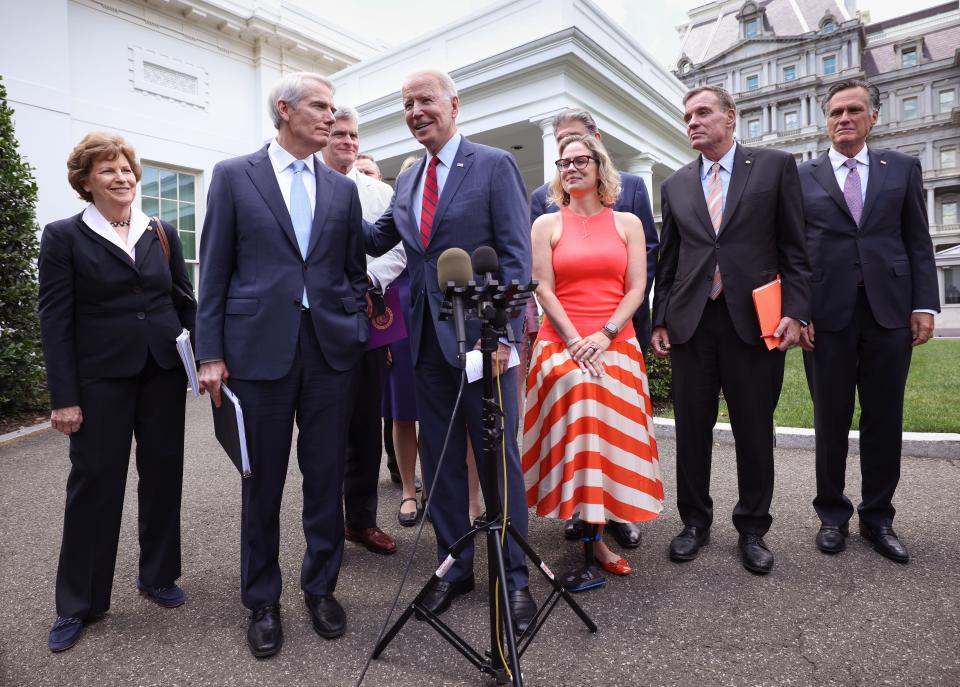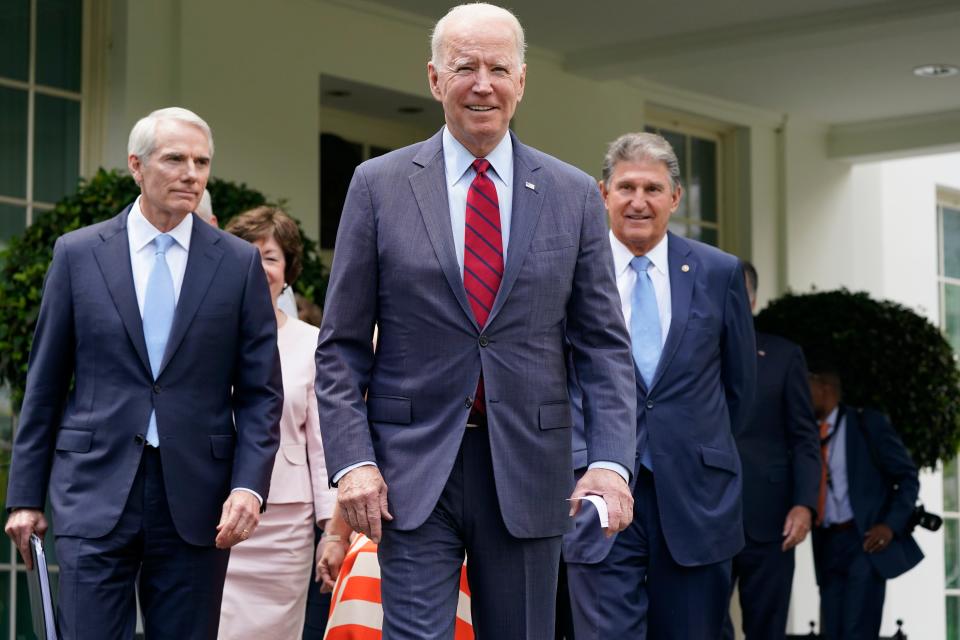What’s bipartisanship and why does Joe Biden care so much about it?
- Oops!Something went wrong.Please try again later.
When President Joe Biden emerged from the White House Thursday to announce that a deal had been struck on a national infrastructure plan, he was tailed by an unfamiliar sight: a group of smiling senators, half of them Democrats and the other half Republicans.
The compromise on a plan to update the country’s deteriorating transportation and public works systems — made among the president, 11 Republican senators and 10 Democratic caucus senators — was lauded as a long-awaited return to bipartisanship.
“This reminds me of the days when we used to get an awful lot done up in the United States Congress,” Biden said Thursday.
The president has aimed to make unity and compromise central to his time in office. But not everyone in Washington is sold on the effort.
Here’s a look at Biden’s relationship with bipartisanship and why it matters.
What is bipartisanship?
It’s hard to pin down a one-size-fits-all definition for the term “bipartisanship.” In some contexts, like that of the infrastructure plan, a deal is bartered among several members of opposing parties, leading to vast compromise on both sides. In others, it might just mean one or two votes from across the aisle.

But in most scenarios, it can be boiled down to cooperation between two typically opposing political parties — a feat that many Americans fear is unreachable on a large scale.
A study conducted by Pew Research Center after the 2020 election found that just 21% of Americans believe relations between Republicans and Democrats would improve this year. Still, that figure has more than doubled since the 2018 midterm election, when about 9% of Americans thought relations between the two parties would improve, according to the study.
Why does it matter to Biden?
Biden has remained more hopeful than most that the two parties will find common ground. He ran his presidential campaign on promises of unity, often romantically calling the search for compromise part of a “battle for America’s soul.”
“Democracy requires consensus,” Biden said Oct. 12 during a campaign speech in Cincinnati. “I’m running as a proud Democrat, but I will govern as an American president. There will be no blue states and red states with me. It’s one America. I’ll work with Democrats and Republicans.”
Biden’s nearly 50-year political career reflects the rhetoric of meeting people halfway he used throughout his presidential campaign.
As vice president to former President Barack Obama, Biden often took the reins on negotiations with senators. In the early days of his first presidency, Obama tasked Biden with convincing GOP senators to support an economic stimulus bill amid the Great Recession. According to POLITICO, Biden called one Republican senator 14 times and tracked down another in their hometown to talk. He ultimately sealed the deal.
As a senator, Biden also sought compromise. A bipartisan index created by the Lugar Center, a nonprofit that advocates for bipartisan governance, found that for a Senate lifetime record of bipartisanship, Biden ranked in the top 20 percent of the 250 senators ranked.
But Biden’s definition of bipartisanship has evolved since taking office, some say. While the term has typically referred to support among elected officials of both parties, Biden’s team has recently suggested the focus on two-party support should center on other party members: voters.
“If you looked up ‘bipartisan’ in the dictionary, I think it would say support from Republicans and Democrats,” Anita Dunn, a senior Biden adviser, said in April. “It doesn’t say the Republicans have to be in Congress.”
What about lawmakers’ stance on bipartisanship?
Despite Biden’s efforts, key leaders of both parties aren’t fully sold on the president’s approach to bipartisanship.
On June 8, Senate Minority Leader Mitch McConnell proclaimed that “the era of bipartisanship is over,” apparently referring to a disagreement in negotiations on the infrastructure package.

Though Biden and the bipartisan group of 21 senators ultimately reached an agreement Thursday, top leaders from both parties appeared to put their feet down on outside stipulations to the agreement.
“There won't be an infrastructure bill unless we have a reconciliation bill. Plain and simple,” House Speaker Nancy Pelosi said Thursday.
“That’s not the way to show you’re serious about getting a bipartisan outcome,” McConnell later retorted.
This article originally appeared on USA TODAY: What’s bipartisanship and why does Joe Biden care so much about it?

